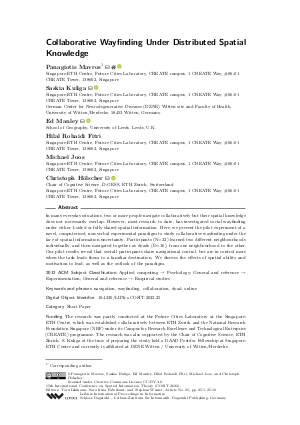@InProceedings{mavros_et_al:LIPIcs.COSIT.2022.25,
author = {Mavros, Panagiotis and Kuliga, Saskia and Manley, Ed and Fitri, Hilal Rohaidi and Joos, Michael and H\"{o}lscher, Christoph},
title = {{Collaborative Wayfinding Under Distributed Spatial Knowledge}},
booktitle = {15th International Conference on Spatial Information Theory (COSIT 2022)},
pages = {25:1--25:10},
series = {Leibniz International Proceedings in Informatics (LIPIcs)},
ISBN = {978-3-95977-257-0},
ISSN = {1868-8969},
year = {2022},
volume = {240},
editor = {Ishikawa, Toru and Fabrikant, Sara Irina and Winter, Stephan},
publisher = {Schloss Dagstuhl -- Leibniz-Zentrum f{\"u}r Informatik},
address = {Dagstuhl, Germany},
URL = {https://drops-dev.dagstuhl.de/entities/document/10.4230/LIPIcs.COSIT.2022.25},
URN = {urn:nbn:de:0030-drops-169105},
doi = {10.4230/LIPIcs.COSIT.2022.25},
annote = {Keywords: navigation, wayfinding, collaboration, dyad, online}
}

 Creative Commons Attribution 4.0 International license
Creative Commons Attribution 4.0 International license


